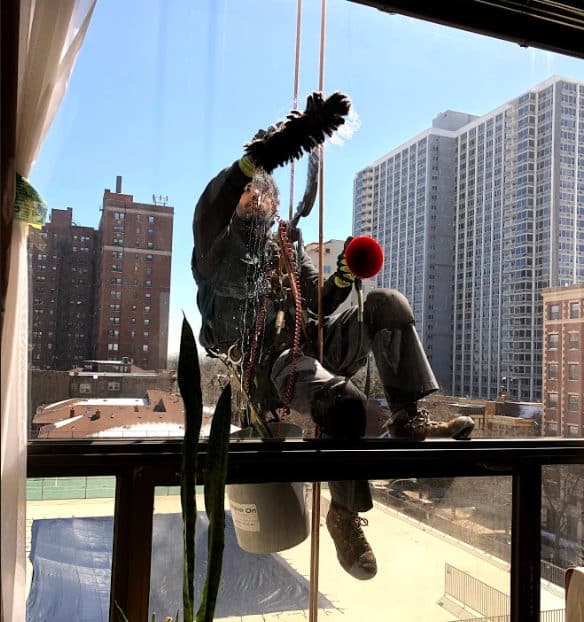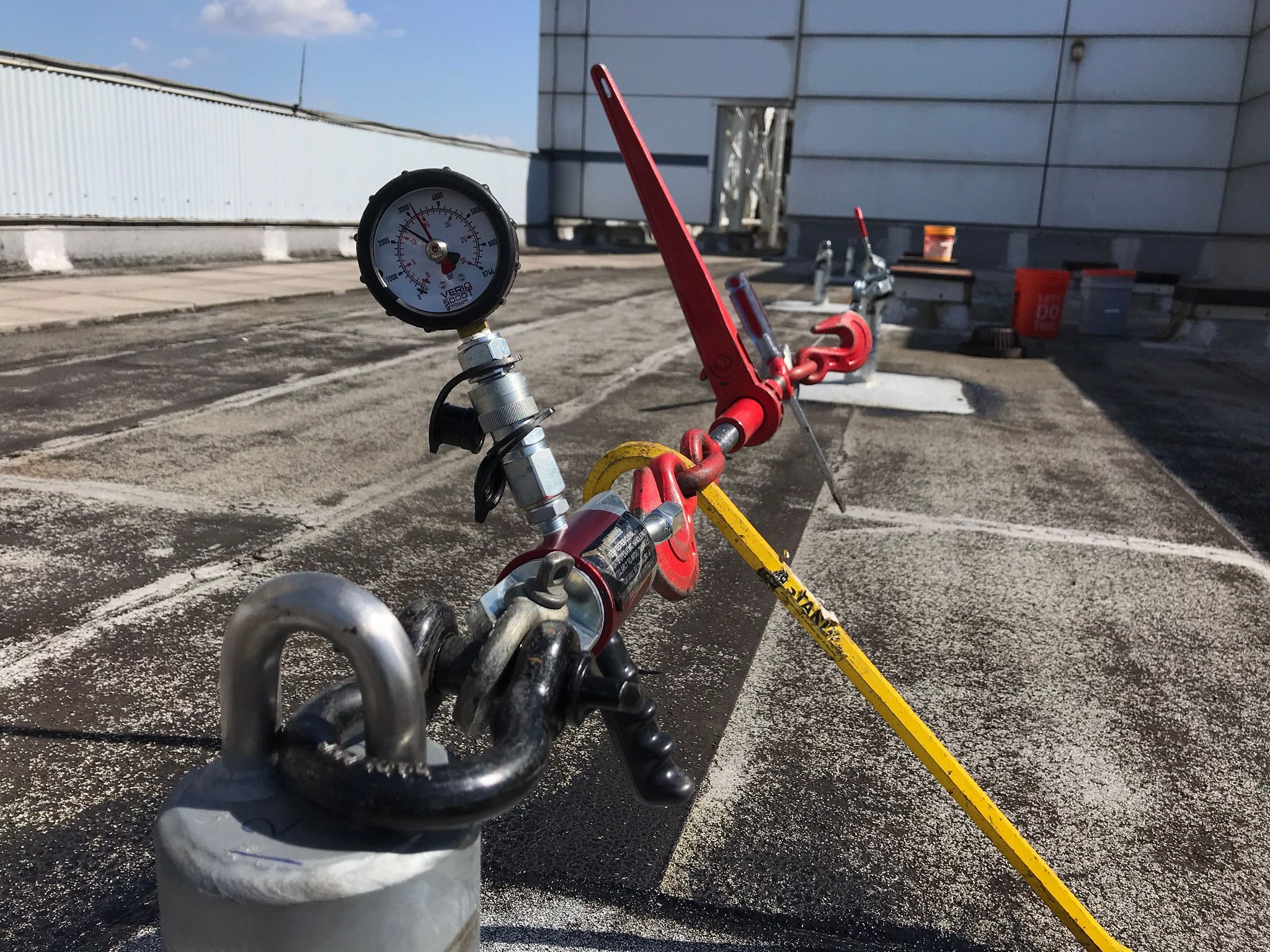In the following posts you will find information and guidance on acceptable practices and procedures to protect persons from the hazards associated with rope access work methods when working at height.
Defined Terms
Access work plan: A written statement prepared by the employer describing how a particular job (or types of jobs where these will be essentially identical) should be undertaken to ensure any risks to health and safety of the workers, or others who may be affected, are minimized or eliminated. The documentation prepared by the employer describing how a particular job or jobs should be undertaken may have different titles such as access work plan, access permit, work plan and tailboard form.
- Access zone: The area in which people are at risk of falling such as on-rope or near a working edge. This area requires protective measures such as verbal warnings, signs, barriers, safety lines, or other devices designed to prevent or arrest a fall.
- Aid climbing: A method of vertical or lateral movement in which the rope access technician moves from one anchor to another closely placed anchor.
- Anchor, anchorage: A place, fixing or fixture that supports and to which the various ropes and rope systems are attached.
- Anchor, main: Main anchors are located at the top of and provide the primary support for the life-safety system.
- Anchor, deviation: Deviation anchors change the direction of the rope system. In common practice, the rope does not connect to a deviation anchor, but runs through a carabiner or connector. In general use a deviation anchor should not pull the rope system more than 20 degrees off of the vertical.
- Anchor, rebelay: A rebelay is a type of anchor located below the main anchor and used to direct the rope away from the fall line. The rope connects to a rebelay anchor.
- Anchor, load sharing: Several anchors connected together to make a single anchor that meets the strength required for rope access work.
- Approved equipment: Equipment deemed appropriate for use with rope access techniques. Approved equipment shall meet the specifications set forth herein, or other specifications set forth in the access work plan, if more stringent.
- Ascender: A type of rope grab that is used primarily for climbing a rope by gripping the rope when loaded in one direction and sliding freely in the opposite direction. Ascender-type rope grabs come in a variety of designs. Many of those designs are not appropriate to use as a connection to the safety line or for belaying a person.
- Belay: A system operated by a rope access technician for the purpose of arresting the fall of another person.
- Carabiner: A type of connector, formed as a complete loop with a spring-loaded entry gate.
- Carabiner, Locking: A carabiner with a mechanism that reduces the possibility of a gate being opened inadvertently. A locking carabiner may include the standard screw-gate or other style carabiner in which a positive action is required to lock the gate.
- Carabiner, two-stage locking: A locking mechanism that requires at least two different consecutive manual actions to open the gate.
- Carabiner, three-stage locking: A locking mechanism that requires at least three different consecutive manual actions to open the gate.
- Carabiner, self-locking: A gate that locks automatically when it closes. May also be called auto-lock, quik-lok, or some variation of those terms.
- Descender: A device that acts as a brake on a rope. Descender usually refers to a device attached to the operator and enables the operator to control the rate of descent down the rope. Many descenders may be attached to an anchor and used to control the rate of descent of a worker or equipment being lowered.
- Dynamic rope: A rope that is specifically designed to absorb the energy of a fall by extending in length thereby minimizing the shock load to the worker, rope system, and anchors.
- Employer: A corporation, partnership, proprietorship, government agency, or other organization that authorizes its employees to perform rope access work.
- Fall arrest: Equipment, system, or structure that arrests the fall of a worker.
- Fall factor: The maximum distance a person could fall, divided by the length of the rope attaching the person to the anchorage
- Fall prevention: Equipment, system, or structure that prevents a fall from occurring.
- Hazard zone: Any area where a person may be at risk as a result of the work being performed. The hazard zone is concerned with the risk that the public or other workers may be struck by a falling object. This includes the workers on-rope as well as anyone at ground level.
- Job safety analysis: A component of the access work plan which identifies hazards, the hazard mitigation methods and outlines requirements to promptly rescue a rope access technician. The component of the access work plan which identifies hazards, the hazard mitigation methods and outlines requirements to promptly rescue a rope access technician may have different titles for different employers, but will contain the basic information. Names often used include job safety analysis, site specific safety plan, hazard analysis, tailboard form and risk assessment.
- Kernmantle rope: A rope consisting of an internal load-bearing core enclosed within a separate braided sheath.
- Low stretch rope: Rope that has an elongation of 6% to 10% at 10% of minimum breaking strength. See also Static Rope.
- Main or Working Line: The primary rope used for descending, ascending or positioning.
- Minimum breaking strength: Manufacturer’s rating used by the employer to calculate safe working loads.
- On-rope: The condition of being suspended from or attached to a rope.
- Proof load: A test load applied to verify that an item of equipment will not exhibit permanent deformation under that load, at that particular time.
- Rescuer: A person performing a rescue other than the rescue subject of the rescue.
- Rescue service: Organization determined by the employer to be capable of safe and effective rescue of rope access technicians.
- Retrieval: Procedure for rescuing rope access technicians without placing a rescuer on-rope.
- Retrieval system: The equipment (including a retrieval line, harness, lifting device, and anchor) used for rescue of rope access technicians without placing a rescuer on-rope. The safety line may be used as the retrieval line in a retrieval system.
- Rope access: A means of access by descending or ascending a main line while the worker is protected by a safety line. Rope access also includes the use of climbing and aid climbing techniques with fall protection. Rope access technicians use a variety of rope based skills and equipment to access buildings, other structures (on or offshore), geological features (such as cliff faces), or manmade features (such as dams). A rope is used as the primary means of support and a safety rope is used to attach the fall arrest Climbing and aid climbing techniques used by rope access technicians may use techniques other than a safety line for fall protection such as positioning lanyards, backup lanyards and bypass lanyards.
- Rope Access Program Administrator: A person authorized by their employer to be responsible for managing the employer’s rope access program, who is suitably knowledgeable, experienced, and qualified to manage the rope access program, including matters relating to safety, training, regulations, staffing, equipment selection and management, and other program responsibilities as designated by the employer.
- Rope access technician: A person who has completed a rope access certification program and has the appropriate training and experience to perform the duties required according to the assigned level of responsibility. There are three levels of rope access technician.
- Level III Technician (Rope Access Supervisor): A person with the training, skills, experience and certification necessary to assume responsibility for the entire rope access work site, including management and guidance of other rope access technicians on the work site, who is capable of designing, analyzing, evaluating and specifying rope access systems, and who has the knowledge and experience to direct rescue operations from rope access systems, as well as the skills necessary to perform advanced rescue from rope access systems.
- Level II Technician (Rope Access Lead Technician): A person with the appropriate training, skills, experience, and certification to perform, under the direction of a Rope Access Supervisor, all rope access rigging, work and, at a minimum, has the skills necessary to perform standard rescue from rope access systems.
- Level I Technician (Rope Access Worker): A person with the appropriate training, skills, and certification for performing, under the direct supervision of a Rope Access Lead Technician or Rope Access Supervisor, standard rope access operations and, at a minimum, has the skills necessary to perform limited rescue from rope access systems.
- Rope grab: A device used to grasp a life safety rope for the purpose of supporting a load.
- Safe working load (SWL): The designated maximum force that may be placed on an item of equipment as calculated by the employer from the minimum breaking strength.
- Safe zone: Any area outside the hazard zone or the access zone.
- Safety, secondary, belay or backup line: Rope used to protect against falls if the user slips or the primary support, anchor or positioning mechanism fails.
- Safety factor: The minimum strength of the system divided by the maximum anticipated load expressed as a ratio.
- Shall: The word “shall” is to be understood as denoting a mandatory requirement.
- Should: The word “should” is to be understood as denoting a recommendation.
- Static rope: Rope that has an elongation of 6% or less at 10% of minimum breaking strength. See also Low Stretch Rope.



